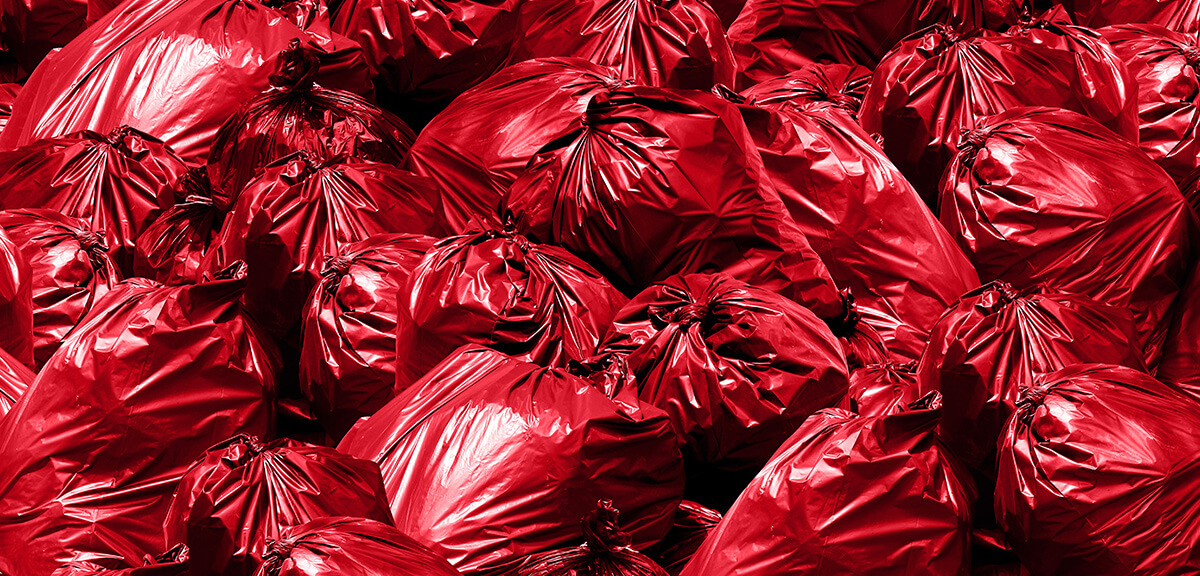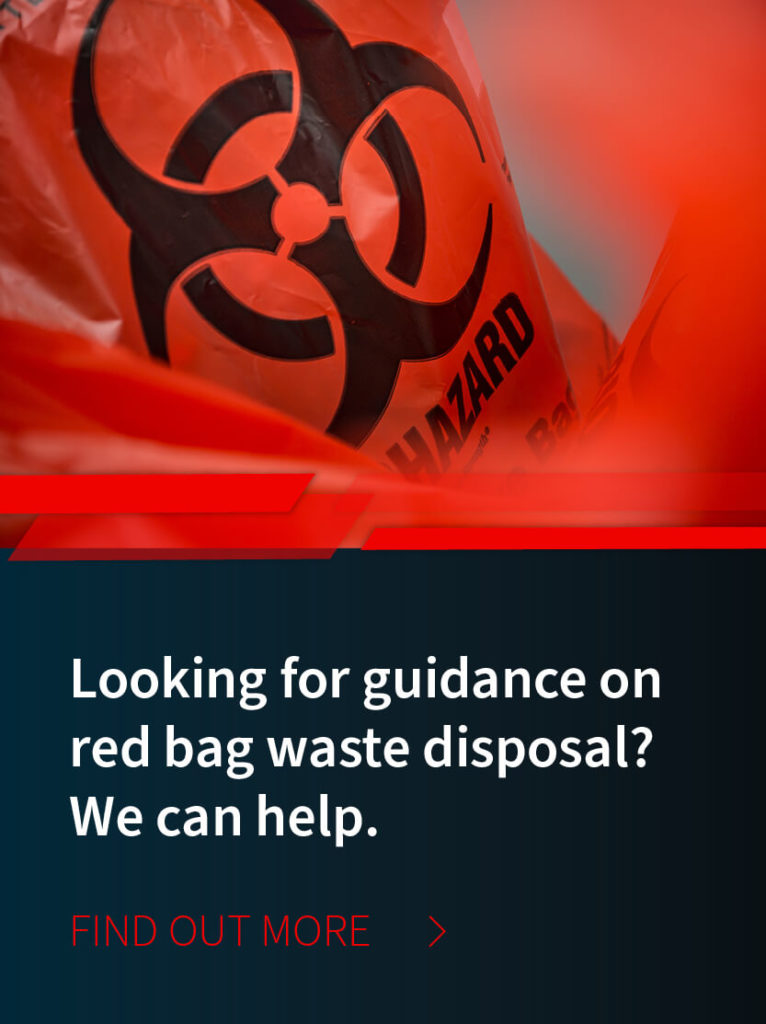
/ IN THIS BLOG
01 / Defining ‘Red Bag’ Waste
‘Red bag’ waste is most easily defined as biomedical waste. What does that mean for you? It means that anything that is contaminated with blood, body fluids, cytotoxic materials, or sharps are deemed biohazardous and must be properly separated from other medical waste.
Biomedical or biohazardous wastes are regulated, meaning federal and state governments have specific guidelines and rules for its collection, storage, and disposal. Regulated medical waste is ‘regulated’ for a reason. Proper and timely identification of such waste ensures safety for those collecting it, keeps it out of the hands of the public, and makes sure that it is properly disposed of through autoclave sterilization or incineration processes.
‘Red bag’ waste is known by other names, such as:
Biohazardous material
Regulated medical waste
Infectious waste
Biohazard waste
Sharps waste
Such terms are simply different ways of saying the same thing. Every state uses their own terminology and definitions to identify biomedical/biohazardous waste. Access your state’s Administrative Codes for their definitions. Remember that a red bag waste is any material that has been contaminated with blood or other potentially infectious materials (OPIM), and as such, they cannot go directly into the trash.
Disposal processes must comply with federal medical waste regulations. In addition, every state throughout the country also has their own medical waste regulations that not only comply with federal guidelines, but often exceed those requirements. You must follow both. The Environmental Protection Agency (EPA) offers access to state environmental agencies and hazardous waste programs throughout the U.S.
So, in addition to safety, there is a monetary-based incentive to proper biohazardous waste disposal. Mismanagement of biomedical or red bag waste can trigger a rise in costs of waste disposal. How? By not tossing non-biohazard waste into ‘regular’ trash bins or into biohazard bags or containers.
02 / What is NOT a Biohazardous Waste?
The following are just a few items that healthcare professionals and support staff commonly toss into in red bag waste or biohazard waste container but don't need to:
Gloves, masks, or gowns that have not been in contact with blood or other potentially infectious material
Opened but unused bandages or gauze
Gloves, masks, or gowns that have not been in contact with blood or other potentially infectious material
Standard trash (coffee cups, food scraps, packaging, etc.)
These items end up in red bags largely due to lack of knowledge in medical waste stream management and protocols associated with them. Education and proper disposal is key not only in enforcement, but in cost savings.
03 / How Does Proper Disposal of Red Bag Waste Save You Money?!
Not all waste is created equal, nor is it disposed of in the same way. Proper disposal of red bag waste can save your facility money by ensuring that your medical waste stream management processes are followed. It costs more to transport and dispose of biohazardous or industrial hazardous waste because those transporters must be properly trained and certified to transport such waste. That waste must also be specially treated to render it non-hazardous before it can be disposed of in a landfill.
If an employee puts one single biohazardous item (such as a used and bloodied wound care kit or sharps used to treat an infectious patient) into a ‘regular’ non-hazardous waste receptacle (regardless of size), that entire receptacle must now be considered hazardous or contaminated waste and must be disposed of as such – and with associated costs.
Conversely, staff that places non-hazardous items into the biohazard bag or container has now just added volume or weight to that bag or container, driving up disposal costs.
Proper segregation or separation of medical waste streams ensures that you only pay for transport, shipment and disposal of biomedical/red bag waste and not otherwise harmless waste that has been contaminated by a careless employee.
As the generator of medical waste, you can't influence every element of waste management pricing. For example, if you have to pay to ship each box of biohazardous waste, you can't necessarily change the per-box rate (barring changing medical waste management companies). However, you can ensure you're not shipping more boxes than necessary. This is where educating your staff about what truly constitutes red bag waste comes into play.
If your staff is throwing away general trash in red bags, you end up shipping far more boxes of medical waste than you need to - and subsequently paying more than necessary.
04 / Education is Key
The importance of educating your staff about regulated medical waste disposal cannot be overstated. If your staff members are not up to date on these regulations, you can't expect them to properly comply with the laws. By the same token, if they aren't fully aware of proper biohazard waste protocol, how can they be expected to follow it?
At the very least, every employee in a healthcare environment should be familiar with the Occupational Safety and Health Administration’s (OSHA) Bloodborne Pathogen Standards.
This is a large part of why OSHA bloodborne pathogens training and needlestick prevention training is mandatory in a number of scenarios. To date, 28 OSHA-approved state plans are in place. Requirements may differ by state, though anyone working with patients is strongly urged to comply with these training standards.
To protect your facility from issues of non-compliance or improper red bag or biohazardous waste disposal processes, your entire staff should benefit from OSHA training and stay up-to-date on such issues. Again, doing so benefits everybody. Your staff, patients, and people in contact with the waste are safer when it's properly disposed of, and you also see monetary benefits in avoided OSHA fines.
05 / Keeping Medical Waste Disposal Costs Down
By keeping standard or non-regulated medical waste and trash out of your red bag waste, you can simply and legally cut down on the volume of red bag or biohazardous waste that needs to be transported off-site for treatment and disposal.
Understanding of federal and state laws as well as OSHA regulations are all important factors in maintaining compliance and saving on disposal costs. Your medical facilities can save money by knowing what does (and doesn't) need to go in red bags. At the same time, be diligent. In order to keep costs down (especially for facilities that generate biomedical/biohazardous waste) there may be a temptation to cut corners and throw blood-contaminated materials into the ‘regular’ garbage just to cut down on waste disposal costs.
However, if blood-contaminated waste is not treated properly in medical waste autoclaves or other treatments based on contents, your facility might put people and the environment at serious risk of bloodborne pathogens. Be aware that any issues of non-compliance – even after medical waste has left your property – it is YOUR responsibility. The buck stops with you, and it is you and your facility at risk of fines for non-compliance.
Fines for non-compliance average $50,000 per day per violation, not to mention damage to your reputation. The goal, therefore, is not to take risks to save a few dollars. Rather, train your staff with as much information as possible to avoid problems with compliance. Properly train staff in waste stream identification, especially when it comes to biomedical, hazardous, and infectious waste streams.
For more healthcare waste management tips or ways to properly manage your medical waste disposal costs, contact a representative of MCF Environmental Services, a trusted medical waste management company based in Atlanta. With over three decades of experience in healthcare and hazardous waste management processes, we can help ensure safety for your staff and patients, but also maintain federal and state compliance with your waste protocols.
Robert Losurdo
President, COO








